June 23, 2017: 11:00am - 1:00pm
THIS IS A TRANSCRIPT FOR THE TRIBAL TECHNICAL ASSISTANCE PROGRAM WEBINAR ON JUNE 23, 2016.
>> Good morning. While we are waiting, I would like to point you to the screen. There are two poll question's we would like for you to answer. Is easy to address these if you have not done one before. Just click on the radio buttons on the left to answer the question. If you want to change your vote you can just click on another button that you can only vote one time. We will be starting soon.
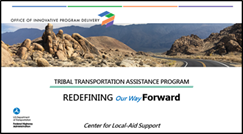
>> Good day. Thank you for standing by. Welcome to this presentation Tribal Technical Assistance Program redefining our way forward.
All participants are in listen only mode and later we will of the lines for question. We are recording this webinar so it may be replayed later and the audio is broadcast only through the telephone lines and not three a computer. Just to avoid the background noise we have put everyone in listen only mode but if you would like to unmute your line press star 6. To mute your line again press star 6 again. Lastly, we will be asking for comments in two ways. You can put your comment in the chat pod on the bottom left or when it is time at the end you can unmute your line using star 6 and ask your question. This webinar is now being recorded and I would like to turn this over now to our presenter Victoria Peters.
>> Thank you, Roger. Good morning to everyone. We are very pleased that you can join us today. My name is Victoria peters I am the director of the Center for Local Aid Support in the Federal Highway Administration's Office of Innovative Program Delivery. We want to make this presentation interactive so please post your comments and questions over in the chat pod that is over on the bottom left. As we go through this presentation at the end we will be given instructions on how to give your feedback over the phone line if you're more comfortable in providing it that way. First we will have Tony our Chief Innovation Officer provide us with a few opening remarks.
>> Hello?
>> Hello, can you hear me?
>> Yes
>> Thank you Victoria and Good Morning to all of you on the webinar. When Victoria and I assumed responsibility for the Tribal Technical Assistance Program about a year ago we had five-year contracts We had five-year contracts can someone put their telephone on it mute please? We had five-year contracts for three centers that were expiring and the other four had completed their base years and were into their option years. These contracts started at different times and were based on different Statements of Work. As we thought through how we would proceed, we began evaluating where the program was in its delivery of services to the tribes. We looked through the existing statements of work and, more importantly, looked through the data that the Centers themselves provided to us on the delivery of training and technical assistance to the tribes. Then we started thinking through options. Our focus through all our thinking, then and now, is how can the TTAP best meet the needs of the tribes in transportation training and technical assistance. How can we focus more resources on providing the basic mission of this program? Is the current model for delivery of the TTAP the best model? Can we consolidate administrative functions to reduce overhead and shift that time and energy into training and technical assistance? Can we leverage other resources? Can we take advantage of advancements in learning options while maintaining face-to-face interaction to help the tribes solve particular problems? I want to thank the Tribal Transportation Program Coordinating Committee for their invaluable assistance in vetting options and helping us shape our thinking. It was this Committee that advised us to seek broader input from the tribes and it was their recommendation that was the genesis for these webinars. As Victoria noted her letter to all of you announcing these webinars, in order for us to be able to put the full scope of our proposal before you in these webinars, we had to put a draft SOW in the public domain. Since that's now been done, we can proceed in that broader conversation with you.
Victoria will now walk you through the model we are proposing for the delivery of the TTAP, but before she does, I want to thank her publicly for her efforts in pulling this together. Victoria has poured herself into looking for ways to deliver the best possible program to the tribes. Thank you, Victoria.
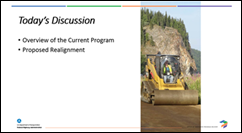
>> Thank you Tony. I will now give you a little background of the current program and walk you through some key concepts of our proposed new model.
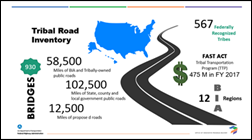
>> The Federal Highway Administration has the broad responsibility of ensuring that America's roads and highways continue to be the safest and most technologically up-to-date. State, local, and Tribal governments own most of the Nation's highways and FHWA provides financial and technical support to them for constructing, improving, and preserving the highway system. The tribal road inventory currently consists of approximately 58,500 miles of BIA and Tribally-owned public roads, 102,500 miles of State, county and local government public roads, and 12,500 miles of proposed roads. This inventory also includes 930 bridges. All statistics that I'm sure you're very familiar with. The FAST Act continued the Tribal Transportation Program (TTP), which provides highway access to basic community services to enhance the quality of life in tribal communities. The program is receiving $475 million in FY 2017, with increases of $10 million per year to $505 million in FY 2020. The FAST Act allocates TTP funding to the Tribes through a statutory formula based on tribal population, road mileage and average tribal shares. A portion of the Tribal Technical Assistance Program is funded under the TTP set-asides.
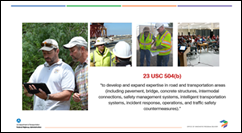
>> The larger portion of the funding comes from FHWA's Training and Education program. In 1981, the concept of a rural technical assistance program first appeared in a conference committee report on appropriations for the U.S. DOT. It wasn't until 1991, that Congress widened the program's scope to include Tribes under the Technical Assistance Program. This expansion authorized the program to directly serve Native American tribal governments. Since the Intermodal Surface Transportation Efficiency Act was signed into law on December 18, 1991, the Tribal Technical Assistance Program can officially celebrate 25 years of TTAP legislation. Four TTAP centers were initially established in Colorado, Michigan, Montana, and Washington. The TTAP Center at Oklahoma State University (OSU) was started in 1995. Also, that year, a sixth center began operation in California, followed shortly by a seventh center in Alaska.
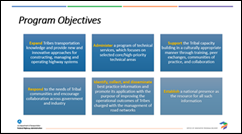
>> The overall objective of the TTAP is to deliver a highway training curriculum and technical assistance to provide the tribes with tools to build their capacity, means to innovatively address their roadway network challenges, and be reflective of FHWA's current core areas. The key objectives for the TTAP are identified on the slide. They include expanding knowledge and providing new innovative approaches focusing on selected high priority technical areas, supporting tribal capacity building, encouraging collaboration across government industry, disseminating best practices and establishing national presence as a resource for these materials.
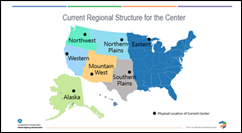
>> Currently, there are seven TTAP Centers include the Mountain West TTAP Center in Gilbert, AZ; the Northwest TTAP Center at Eastern Washington University; Eastern TTAP Center at Michigan Tech University; the Alaska TTAP Center at the University of Alaska-Fairbanks, AK; the Western TTAP Center at the National Indian Justice Center (NIJC) in Santa Rosa, CA; the Northern Plains TTAP at the United Tribes Technical College in Bismarck, ND; and the Southern Plains TTAP Center at Oklahoma State University.
The structure of these centers was developed in 1991. Let's step back and review what was happening a quarter of a century ago. The Intermodal Surface Transportation Efficiency Act restructured the federal-aid program. It was considered the most important bill since President Eisenhower started the Interstate System. It was considered the start of a “new era for transportation” focusing on system performance rather than system building. The conflict in the Persian Gulf had ended and President Bush's first priority was to get the economy rolling again and enact the legislation that is key to building a better America. Sound familiar?
The first website went live in 1991 and the internet was used by physicists and scholars. Now the internet has changed literally everything that we do - how we keep in touch with friends and business connections, the way we shop, and how we get our news - it's all changed over 25 years. Remember encyclopedias, they are now obsolete, information is gained on a click of a button. In 1991, big bulky notebook computers hit the market. Hard drives were a whopping 80 MB and they had floppy disks! The second generation or (2G) phone technology hit the market in Finland. It was another 10 years before 3G was launched and of course we all want 4G at this point. Kodak introduced their digital camera and we probably have some gamers online. So it's notable that super Nintendo was launched and a gallon of gas was a dollar and 12 cents.
In the pre-Personal Computer era, futurists predicted huge changes in transportation. By 2008, we would be flitting about in personal jetpacks and taking vacations on the moon. But the communications revolution, spurred by personal computers and the Internet, wasn't on anyone's radar.
The next quarter century still may not have us commuting using jetpacks, but we will see technology used that as you approach a dangerous intersection, sensors in your car will detect it and reduce speed. Construction processes and methodologies will continue to evolve. We will manage our networks with real-time travel data. Once again our Nation's transportation community is entering an unprecedented “era of change”. One thing for sure is that it will continue to be difficult for agencies to attract and retain a capable workforce. As much as 50 percent of the transportation workforce will be eligible for retirement in the next decade. (How many of you will still be working?) As these workers depart, they will take valuable knowledge and skills with them.
Today, massive amounts of information are available at your fingertips. Opportunities for communication and collaboration have also been expanded by technology. Today, technology enables forms of communication, training and collaboration undreamt of 25 years ago. The walls of the regional boundaries or training rooms are no longer a barrier. The advancements over 25 years have profoundly changed our ability to deliver training and education and lends itself to reconsidering a new delivery model.
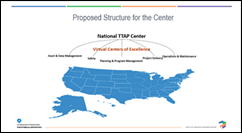
>> FHWA is proposing a two-year pilot to maintain one national TTAP center. Operated under the national Center will be 5 Virtual Tribal Centers of Excellence providing expertise best practices, support and training in the highway areas of asset and data management, planning and program management, project delivery, safety, operations and maintenance and included without a national tribal road scholar certificate program. By establishing a national tribal technical assistance program, a national TTAP center the FHWA proactively creates cadre of professionals, specialist in critical Highway topics.
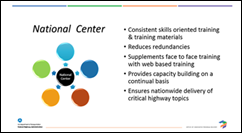
>> The mission of the national TTAP center will be to provide and facilitate quality training and technical assistance for Tribes in support of the highway program. The center's leadership ensures that its training and technical assistance programs promote a technically capable tribal workforce. One priority will be to provide consistent skills based training on issues that challenge tribes in managing and operating their road networks. Many of the past administrative functions of the seven-center model are placed under the national center to reduce redundancies and to make more of the funding available for training and technical assistance and to support travel for face-to-face interaction between the subject matter experts and the tribes. A second priority is to ensure that the greatest number of tribes are served at the lowest cost. To this end, a combination of training delivery methods will be incorporated into the center's delivery. The Center will be asked to work closely with the LTAP centers in the states in which the tribes reside to take advantage of existing training delivered by LTAP centers. Most importantly, the national center will be responsible for ensuring training and technical assistance is delivered across all 12 BIA regions.
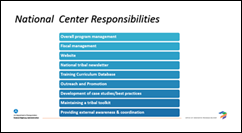
>> In additional to overall program management, the staff assigned to the national center will be responsible for developing a national tribal website. The website will be a one-stop shop for tribes to obtain training information, find resources, learn about best practices and share transportation news. A quarterly electronic newsletter will be produced to share program updates, highlights, upcoming events and tribal success stories. The national center will manage a database of the TTAP training curriculum, develop tribal case studies and create a tribal toolkit that contains guidance documents, sample policies, standard specifications and plans, and example templates used in delivery of the transportation program. The national center will coordinate with state and local governments, academia and industry organizations and collaboratively facilitate conversations between these entities and tribes. The national center should be considered the tribes point of contact for training and technical assistance needs.
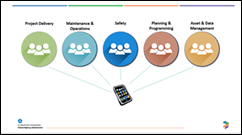
>> The programs footprint will be maximized by operating five virtual centers for training and technical assistance. These centers are virtual and the staff can be seated anywhere in the US. Physical locations for theses Virtual Centers of Excellence are not required. Each of the virtual centers will be comprised of subject matter experts responsible for the delivery of training and technical assistance in their focus area. Once this is in place, you will have experts available at your fingertips. If you have a safety program, you will hear from a safety expert. If you have a maintenance question, a maintenance expert will assist you. These experts will have access to the additional resources of FHWA and other organizations to ensure you get the best information to resolve your questions. The subject matter experts will share their knowledge and expertise across all 12 BIA regions.
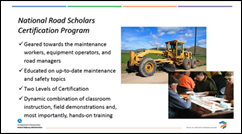
>> In addition to the virtual centers, a national Tribal Road Scholars' Certification Program will be developed. Delivery of the certification program will require a physical location and equipment to provide the necessary skill development for the certification. This program can be co-located with the National TTAP Center or located in another physical location within the U.S. The RS program will provide the most comprehensive and up-to-date skill development in maintenance and operations topics. It will include training on heavy equipment operations such as Motor Graders, Skidsteers, Backhoes, Forklifts, Excavators, Loaders, Haul Trucks and Rollers. The goal is to provide skill development consisting of approximately 50% classroom to 50% field training. Due to the need for field based skill development, equipment availability and facilities that support hands on training, the tribes will need to travel to the Center location to complete some of the Road Scholar curriculum.
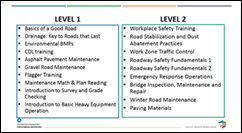
>> The certification will be provided in two levels. Level I and II. Included in the program will include an on-line preparatory course, classroom training, hands on field equipment skill development, examination, recertification and retesting. Proficiencies after each class shall be measured by pre-and post-tests. Individual achievement will be a minimum score of 75%. In the future, when a new employee joins your workforce and they indicate that they have the Tribal Road Scholars certification, you can be confident they have been trained consistent to those on your staff who retain a Tribal RS certification.
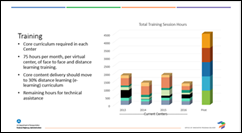
>> Now, I would like to go back and take a closer look at the training that will be provided. Within the statement of work, we have identified a core curriculum in each of the focus areas. The delivery will include basic through advanced training, to build a strong tribal network of roadway knowledge. Training under this contract is set at a minimum of 75 hours per month per virtual center of face to face and distance learning training. To illustrate the impact of this requirement, the graph shows the training hours that have been provided over the past four years in comparison with the proposed amounts under the pilot.
Since we intend to build skills with our training, session length for the core curriculum will range from 4 hours to multiple days. We are also asking that the subject matter experts consider local issues and problems identified by their audience in the delivery. The virtual centers' role IS to deliver training and technical assistance. Specific training and education areas outside of the core curriculum will be identified by the FHWA annually. We have asked the Tribal Transportation Program Coordinating Committee to assist us in identifying new needs.
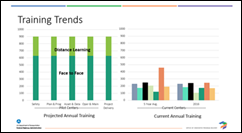
>> As you can see in the first graph, the core content delivery under the pilot will be delivered in both classroom (face to face) delivery, and distance learning. We are asking that the curriculum during the pilot incorporate a 30% distance learning (e-learning) delivery. This will provide tribes with on demand learning in many of the core curriculum topics. On the same scale a comparison is made to the TTAPs 5-year average and their last years training delivery.
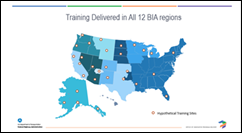
>> Training and technical assistance in each focus area is required to be given across the nation in all 12 BIA regions. For example, the dots represent potential or hypothetical locations of safety training during one year. Then visualize adding a similar number of locations for each of the other focus areas.
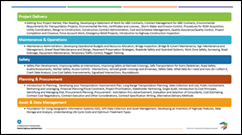
>> As discussed, we have identified a core training curriculum in each of the focus areas. This slide is busy and I don't expect you to read it. However, the busy ness conveys the depth of the curriculum that is important to the Tribal workforce. And then add to this training the Road Scholars certification program for a full package. We will work towards a no-fee structure be employed for training and technical assistance. We know this has varied throughout the regions in the past.
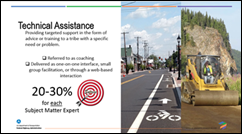
>> Each subject matter expert, in addition to their training role, should anticipate dedicating 20-30% of their time to technical assistance. Technical assistance or coaching is provided on a one on one consultation with an individual or small groups or through web-based interaction. We are requesting that all technical assistance requests and issue resolutions be reported.
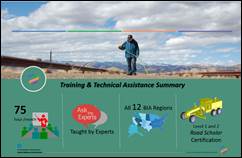
>> So, in summary under this proposal, we are looking for an increase in training and technical assistance provided by the TTAP. Both training and technical assistance will be provided by experts in specific subject areas. The national center will be required to ensure the training program delivered by the virtual centers is delivered in all 12 BIA regions and we will create a national Tribal Road Scholars certification program.
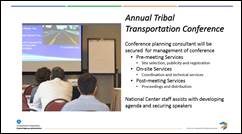
>> Traditionally, the Annual Tribal Transportation Conference has been hosted by one of the TTAP centers. They have been responsible for logistics, registration, securing vendors and speakers and setting the agenda. Starting in 2018, the management of this annual conference will be performed by another entity. We will be soliciting for proposal to provide this service under a separate request later this year. The National TTAP center will assist FHWA in developing the agenda and securing speakers for the event. This will enable more TTAP resources to be dedicated to training and technical assistance.
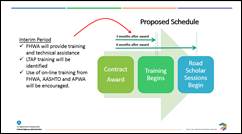
>> Once the contract is set in place, there will be an interim period before the new Center is fully functional. Training by the virtual centers will begin approximately 3 months after contract award. We anticipate the road scholars' facility will take a bit more time to become operational, therefore, we anticipate the program being on line 6 months from contract award. During the interim, FHWA will provide training and technical assistance. We have reviewed the training schedule of past years during the winter months and anticipate meeting the needs with our Resource Center, Federal Lands and Program Office staff. We will also identify and coordinate LTAP training for tribal participation. We also are currently discussing with AASHTO and APWA ways to make their on-line training resources available to both local agencies and tribes.
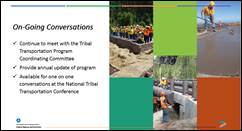
>> This is not the last time you will hear from us. We will continue our conversations. We will work closely with the TTPCC to review performance and identify the future needs of the program. We will provide an annual update in a similar format as today on the success of the pilot program and receive your feedback. Staff from the Center for Local Aid Support will also be available for one on one conversations at the National Tribal Transportation Conference in September.
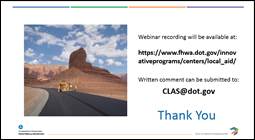
>> After this webinar, we will make the webinar recording available on the Center for Local Aid Support website. As you can see, we have the address up there. You can also provide written comment until July 3 to sending your comments to our email address as shown on the slide.
We really want to hear from you so we were now open the telephone lines to listen to your feedback on what we have presented here today. >> I believe the phone lines are open.
>> If you would like to make a comment --
>> Hello my name is Jennifer Jack from the Salt River [ Indiscernible] Indian community. One comment that I wanted to share is that a lot of our field staff do not have they don't have the computer skills, not technically savvy, that some of the transportation planning staff and other engineering staff have. He makes it difficult for them [ Indiscernible] they are not used to that kind of communication. That is one feedback I would like to offer.
>> That is important. Thank you. In some locations we know that connection is very difficult were going to look into that when we have that web-based on-demand type training we're looking at ways we can do it via video, perhaps we can send you hopefully it will be there that you could someone can start the training up for them so that if they do not have that computer savvy skills, they would not have to rely on trying to navigate the web to get that information. We are looking at alternative ways.
>> Anyone else?
>> This is really your time to share thought's. We want to have this open dialogue so please take this opportunity and sometimes I have to listen to it and let it settle and -- I think I should have said that are mentioned that. Or even the next day. You can provide is written comments into the mailbox if you're comfortable in doing that or if you have that last-minute thought. Also, we will be hosting this same exact webinar on Monday Tuesday and Wednesday of next week so you can feel free to join us again if something -- we are going to leave this open and see here a little while longer. If you want to make comments. We are here and will be here as long as we're getting comments if you do not have any comments, we do not have any more presentation. This is really just comment period so if you have other commitments, you can go. This recording will be on the website. It will include this Q&A period.
>> Hello Victoria?
This is Amy at the Southern Plains TTAP. I think you have some comments in the chat box that someone made instead of calling in.
>> Correct.
>> One is very long. We will have a transcript of this and we will make available for everyone to be able to read. We will put that up right along with the webinar recording.
>> We wanted to give you both verbal and written ways to give us your comments.
>> I'm going to give this a few more minutes but I would like to thank all of you for participating and hopefully you will take us up on sending us your comments through the mailbox.
>> This is Jennifer wants more. Thank you for the presentation and I Jeff Millikan see some pros and cons. I think that travel is always difficult so having things at our desktop would be great. So we can maybe participate in some things without expensive traveling. However, also see that sometimes when things are at the national level, it loses some of that local input. It is always easier to talk to people that you know that are close to home, that you can talk to face-to-face. I think it loses some of the more intimate setting of working with tribes. Anyway, I see both pros and cons and thank you for the presentation.
>> Thank you. We understand that travel is difficult at times and that distance learning component is very important. I have talked to several where they indicated that sometimes it is hard to break away from the day job to go for training but they know that their staff would take training if it was available after hours on the overtime because they want to learn. So having those resources available for staff is important and also so that travel can be difficult and sometimes you need to training immediately if something comes up on a project or within your program and you know that the face-to-face training may be a few months out but that is not going to help you today. Sometimes it is great to have those online resources they are available for you to have that immediate training on -- whether it is just to refresh or to learn something new. With the confidence that in the future, you will also be able to proceed that face-to-face training if you should so desire.
We want to encourage our subject matter experts -- these experts are going to be focused within a specialty area and part of being a subject matter expert is to understand the local on the ground issues when they are providing that technical assistance. We are encouraging them to understand what is going on in forming their technical assistance.
>> Anything else?
>> I think our comments have a slowed down. I am going to say goodbye for today. But I'm going to encourage you to send in any of your thoughts our mailbox will be open for those types of comments until July 3. And of course, we will be presenting this three more times next week.
>> Thank you very much for being here and we really appreciate those who did make comments.
>> [Event concluded]
Victoria Peters: Welcome.
Adam: good morning
Adam: These existing TTAP Centers are crucial to todays Reservation and the services they already offer on the limited budgets they get annually. I just recently attended the 29th Summer Tribal Planning Institute 2017 "Road life Cycle " Tribal Transportation Program. Coordinated by Rowena Yeahquo, NW TTAP Director. What I felt was very important in this Summer Institute was the presenters, Kurt Fredenberg, NW BIA Region, Transportation, Kyle Kitchel, FWHA, TTP, Lewis Yellowrobe, sbriteinc.com, Danny Capri, FHWA, TTP. Like I was saying what was so beneficial in this was the interaction from the different tribal participants at the institute. All participants shared the challenges they were dealing with on their reservations. Listening to this sort of interaction educated me in situations I may encounter in the future. I was so happy to be a part of this program that was coordinated through the existing NW TTAP I have at my fingertips already.
Adam: This will be a great loss to Indian Reservations across the 7 regions.